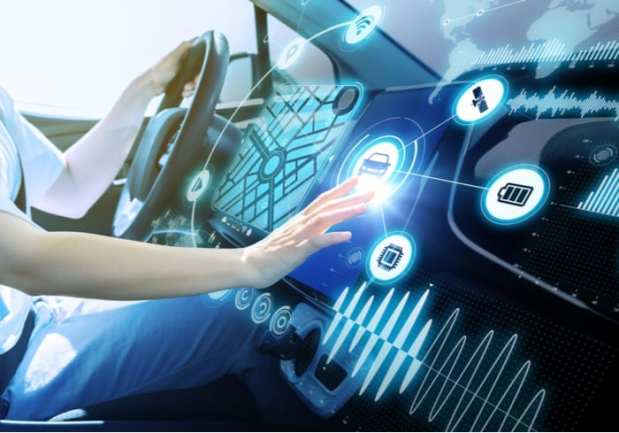Putting Commerce Into The Driver’s Seat With 64M Connected Cars To Hit The Road

With consumers spending more time in their cars than ever before, they want more out of their vehicles than just transportation from Point A to Point B. And while Tesla has been a connected vehicle leader, other players in the industry such as Ford, Daimler and Volvo are launching offerings equipped with technology.
Sixty-four million cars featuring connected tech are expected to ship by the end of the year, according to the PYMNTS Commerce Connected Playbook. Many automakers are already looking into tools and mobile apps to add to the experiences of drivers through infotainment systems. At the same time, connected cars are impacting how quick-service restaurant (QSR)s look at their relationships with diners.
From automakers to retailers and online platforms, companies around the world are tapping into connected commerce technology in automobiles and mobile devices. These are just some of the ways that firms are creating experiences for commerce through connected cars and mobile technology in the digital age:
The share by which Taco Bell’s mobile order values are higher than those made in stores is 30 percent. The quick-service restaurant (QSR) is also bringing new technology into its brick-and-mortar restaurants across the country: The restaurant chain is deploying self-service kiosks. Customers can, for example, substitute beans for beef in the Crunchwrap Supreme to make the dish vegetarian. The QSR chain is also providing diners with an immersive way to experience its brand via The Bell: A Taco Bell Hotel and Resort in Palm Springs, California in the summer for a limited time. Taco Bell Chief Global Brand Officer Marisa Thalberg said in the announcement, “The Bell stands to be the biggest expression of the Taco Bell lifestyle to date. It will be fun, colorful, flavorful and filled with more than what our fans might expect.”
The increase in the number of customers using apps to order foods and drinks between 2016 and 2018 was 150 percent. And eCommerce platforms are getting creative with the menus: Russia’s largest technology company, Yandex, is reportedly beginning a delivery service that will enable diners to request meals from restaurants even if they’re not on the menu. Yandex will make meal kits with ingredients from a meal the diner wants and then send it to a restaurant nearby for preparation. “Restaurants can expand their menu without additional expenses on food, marketing and delivery,” Yandex said in a statement, “even if nearby restaurants aren’t specialized in it.” The meals aren’t anything that a customer can think up, but more of a list of hundreds of popular meals from its food businesses.
The number of cars equipped with some form of connected technology that will be shipped worldwide in 2019 is 64 million. QSRs are tapping into this capability by allowing diners to place orders from their vehicles: Domino’s Pizza, for instance, is bringing in-car ordering to new vehicles this year through the AnyWare pre-loaded ordering platform. The offering will enable diners to use the touchscreen on their vehicles to make orders and will be powered by the Xevo Market automotive commerce platform for connected cars. Domino’s Director of Digital Experience Chris Roeser said in an announcement about the in-car ordering offering, “At Domino’s, we want pizza ordering to be simple and always within reach, no matter where a customer happens to be.”
The portion of millennial parents who would rather not eat at all than wait in long QSR lines is 48 percent. And tech companies are providing consumers with new ways to order ahead or ask for delivery: Google users can now place restaurant orders right from Google Maps, Google Assistant or Google Search, for instance. Through the feature, diners can order without downloading another mobile app. The function operates in Google Search as well as Google Maps via an “Order Online” button that shows up when consumers look for a supported restaurant. Diners can then opt for pickup or delivery and select the service through which they want to place their orders
The number of fast-charging EVA stations currently available for public use in the U.S. is 63,000. At the same time, electric automakers are reportedly eyeing ridesharing. Tesla CEO Elon Musk said per reports in April that he will launch the company’s robotaxi program by 2020. “I feel very confident predicting that there will be autonomous robotaxis from Tesla next year — not in all jurisdictions, because we won’t have regulatory approval everywhere,” Musk said, although he reportedly didn’t mention specific regulations. Those who own equipped Teslas will be able to add their own cars to the ridesharing app from the company that is said to work like Uber or similar firms. The carmaker will reportedly take between 25 percent and 30 percent of the ride revenue and will provide a fleet of robotaxis where there aren’t enough cars to go around.
From Tesla to Domino’s, automakers and retailers are harnessing the power of digital technology to power mobile ordering in addition to other experiences. And, as commuters who value efficiency and speed already want to get the most out of their time driving, merchants and providers of connected cars need to focus on paving the way for these activities without adding friction to their innovations.
